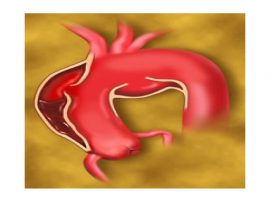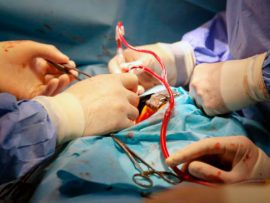Abstract We read with great interest the case presentation by Kaskar et al in the current issue of the World Journal for Pediatric and Congenital Heart Surgery. The authors describe two cases..
Read MoreAbstract Background The most common complication of thoracic aortic disease with shaggy aorta is cerebral infarction. We have performed “low-flow perfusion” as a method of extracorporeal circulation to prevent cerebral..
Read MoreAbstract Objective We designed a simplified total arch reconstruction (s-TAR) technique which could be performed under mild hypothermia (30–32 °C) with distal aortic perfusion. This study aimed to compare its efficacy..
Read MoreAbstract The aortic arch plays a significant role in homeostatic mechanisms to retain blood pressure at stable balance in the cardiovascular system. Therefore, the objective is to estimate and identify..
Read MoreAbstract Objectives Acknowledging lacking of consensus exist in total aortic arch (TAA) surgery for acute type A aortic dissection (AAD), this study aimed to investigate the neurologic injury rate between..
Read MorePonente internacional Perfusionista Alex Muñoz. Empresa CARDIOMED SAC.
Read MoreAbstract The risk of redo sternotomy is greatly elevated in the setting of aortic proximity to the sternum. Current strategies to avoid catastrophic neurologic injury upon sternal reentry include establishment..
Read MoreAbstract Objective (SCI) is a devastating complication of repair. We aim to characterize current practices pertaining to SCI prevention and treatment across Canada. Methods Two questionnaires were developed by the Canadian..
Read MoreAbstract Objective Stroke remains a potentially devastating complication of aortic arch intervention. The value of neurophysiologic intraoperative monitoring (NIOM) in the early identification of stroke is unclear. We evaluated the..
Read MorePatient with Redo operation with previous David operation undergone arch debranching for aortic dissection approach mid sternotomy and off pump. [playlist ids="19618"] Dr.Sam Zeraatian Nejad Davani, CEO of rockingham..
Read MoreAbstract Background Query a single institution computed tomography (CT) database to assess the prevalence of aortic arch anomalies in general adult population and their potential association with thoracic aortopathies. Methods..
Read MoreAbstract Background Acute Stanford type A aortic dissection (TAAD) is a life-threatening condition. Surgery is usually performed as a salvage procedure and is associated with significant postoperative early mortality and..
Read MorePatient with previous cardiac surgery and laryngeal malignancy invaded aortic arch and branches completely made them free and rotational flap applied for coverage of defect. [gallery ids="17637"] Dr.Sam..
Read More[playlist ids="16395"] Dr.Sam Zeraatian Nejad Davani, CEO of rockingham medical research ADKWA center as well as Head of IUMS transplant and cardiovascular surgery department. ..
Read More[gallery ids="13055,13052"]
Read Moreeo echocardio Mohamed Gibreel , FEBR (Fellowship of Egyptian Board of Radiology ) Cardiac imaging consultant at Aswan heart center -Magdi Yacoub Foundation , Egypt ..
Read MoreAbstract OBJECTIVES Organ protective management during aortic arch surgery comprises deep hypothermic (18°C) circulatory arrest (DHCA), or moderate hypothermia (28°C/ ‘tepid’) with regional cerebral perfusion (TRCP). The aim of this..
Read More











